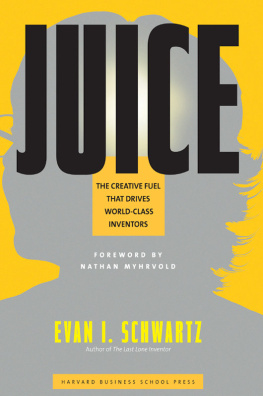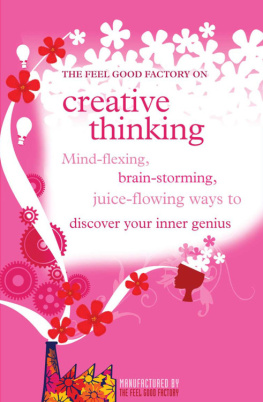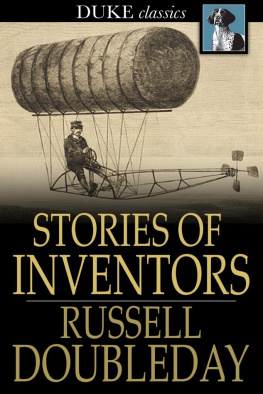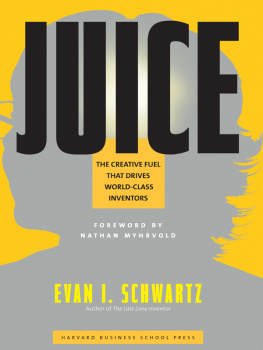Evan I. Schwartz - Juice: The Creative Fuel That Drives World-Class Inventors
Here you can read online Evan I. Schwartz - Juice: The Creative Fuel That Drives World-Class Inventors full text of the book (entire story) in english for free. Download pdf and epub, get meaning, cover and reviews about this ebook. year: 2004, publisher: Harvard Business Press, genre: Romance novel. Description of the work, (preface) as well as reviews are available. Best literature library LitArk.com created for fans of good reading and offers a wide selection of genres:
Romance novel
Science fiction
Adventure
Detective
Science
History
Home and family
Prose
Art
Politics
Computer
Non-fiction
Religion
Business
Children
Humor
Choose a favorite category and find really read worthwhile books. Enjoy immersion in the world of imagination, feel the emotions of the characters or learn something new for yourself, make an fascinating discovery.
- Book:Juice: The Creative Fuel That Drives World-Class Inventors
- Author:
- Publisher:Harvard Business Press
- Genre:
- Year:2004
- Rating:3 / 5
- Favourites:Add to favourites
- Your mark:
- 60
- 1
- 2
- 3
- 4
- 5
Juice: The Creative Fuel That Drives World-Class Inventors: summary, description and annotation
We offer to read an annotation, description, summary or preface (depends on what the author of the book "Juice: The Creative Fuel That Drives World-Class Inventors" wrote himself). If you haven't found the necessary information about the book — write in the comments, we will try to find it.
Juice: The Creative Fuel That Drives World-Class Inventors — read online for free the complete book (whole text) full work
Below is the text of the book, divided by pages. System saving the place of the last page read, allows you to conveniently read the book "Juice: The Creative Fuel That Drives World-Class Inventors" online for free, without having to search again every time where you left off. Put a bookmark, and you can go to the page where you finished reading at any time.
Font size:
Interval:
Bookmark:
JUICE
The Creative Fuel
That Drives
World-Class Inventors
Evan I. Schwartz

Copyright 2004 by Evan I. Schwartz
All rights reserved
Printed in the United States of America
08 07 06 05 04 5 4 3 2 1
No part of this publication may be reproduced, stored in or introduced into a retrieval system, or transmitted, in any form, or by any means (electronic, mechanical, photocopying, recording, or otherwise), without the prior permission of the publisher. Requests for permission should be directed to , or mailed to Permissions, Harvard Business School Publishing, 60 Harvard Way, Boston, Massachusetts 02163.
Library of Congress Cataloging-in-Publication Data
Schwartz, Evan I.
Juice : the creative fuel that drives world-class inventors / Evan I. Schwartz.
p. cm.
Includes bibliographical references.
ISBN 1-59139-288-8
1. Creative ability in business. 2. New products. 3. Creative ability in technology. 4. Technological innovations. 5. Inventions. I. Title.
HD 53.S39 2004
658.575dc22
2004005827
The paper used in this publication meets the requirements of the American National Standard for Permanence of Paper for Publications and Documents in Libraries and Archives Z39.48-1992.
E-book ISBN: 978-1-4221-8406-6
For Amy, and Lily, and Michaela
Nathan P. Myhrvold
INVENTION IS THE ULTIMATE SOURCE of all thats new. Every gizmo, gadget, technique, or tool was born in a flash of inspiration in somebodys head at some point in time. Invention is to technology what conception is to reproductionthe moment that makes something original and unprecedented. As such, it is the highest-value activity that any individual or company can engage in.
The history of our world is, to a large extent, the history of inventions. Some inventions were small incremental improvements, while others were radical and transformative breakthroughs. James Watts steam engine powered the industrial revolution. The nineteenth century saw advances such as the internal combustion engine, steel production, railroads, the telegraph and the telephone, photography and cinema, the elevator, incandescent lighting, electric motors, and the power grid. The twentieth century was driven by the automobile and the airplane, radio and television, atomic energy, electronics, and the digital computer. We may not know exactly which inventions from the worlds of biotech and nanotech will shape the twenty-first century, but we cannot doubt that there will be such inventions. Our world is no longer just inherited from natureit is an invented world.
Despite the incredible impact of invention, it is given short shrift in many circles. Engineering tends to focus on the subsequent development, refinement, and deployment of an idea, paying relatively little attention to invention itself. The bulk of the time, effort, and cost involved in engineering is consumed in these more prosaic, but necessary, steps. In the process, something strange has happened. The attention given to implementing and marketing inventions has, in most organizations, eclipsed invention itself. We take for granted the wellspring of technical innovation that makes all the other hard work possible. Often, this situation is bad enough to actually impede invention. The cart is squarely in front of the horse, and it is seriously getting in the way.
A telling point is that we tend to lump all technology work into the phrase R&DResearch and Development. Where is the I for Invention? Apparently it isnt important enough to mention. Along the same lines, virtually nobody lists invention as his or her primary job task. Engineers are paid to develop products as their first and highest prioritythey either develop products or engage in design and analysis activities directly in support of products. Engineers do make inventions, but it is almost always as an adjunct or side effect of their real missiondesign and analysis. When their main mission gets into conflict with invention, guess which one wins? Stories of great inventions are rife with examples of the almost subversive nature of the activity. Inventors in large companies generally do their work despite, not because of, their jobs.
Start-up companies, on the other hand, must innovate to survive, and this imperative fosters a lot of invention. A lot of the progress in Silicon Valley is made late in the night before a big demonstration or product shipment. Nevertheless, invention is still a sideline activity, and the bulk of the effort is focused on making products and getting revenue. The product imperative that stimulates a certain set of inventions also impedes many others. Its hard to have time for a breakthrough when youre rushing another product out the door. Invention gives rise to start-ups, but new ventures must quickly develop a singleminded focus on product and customers, or else they flounder.
Research organizations tend not to do much better. At its core, research is about learning new things about the world. This can involve invention, but it doesnt have to, and in most cases the primary impetus of a researcher is to produce research, not inventions. I started Microsoft Research in 1991, and Im proud to say we did a tremendous amount of pioneering workwhich is continuing today. But at most big R&D labs, invention is a by-product, not the main product. The same is true in academic settings. Peer-reviewed papers and graduate theses are the main products. Invention is welcome only insofar as it does not get in the way of these primary goals.
Invention isnt easy to do, but it is even harder to manage. Design and analysis tasks have the advantage in that they tend to be predictableat least within bounds. You can ask an engineering manager to produce a schedule for a product design, at least in a reasonably well-known area. The schedule may or may not turn out to be accurate, but it is common practice to at least talk about such a schedule. But ask for a schedule for a dramatic new invention and youll get a blank stare. The same thing occurs in education. It is straightforward to teach analytical methods like stress analysis or to understand the principles of old inventions. As a result, that is mostly what is taughtanalysis and old recipes. Nurturing the creativity of invention is an afterthought, if it occurs at all.
So invention, which is the most important part of technology creation, is systematically given the least attention. You can view this as a problem, but as any inventor will tell you, problem is another way to spell opportunity. That is how it seemed to me and my colleague Edward Jung, the former chief software architect at Microsoft. We began imagining what our dream laboratory would look like and do. We asked all kinds of questions: Why cant invention be the goal in and of itself? Why cant we hire inventive people and let them cross-pollinate ideas across infotech, biotech, nanotech, or whatever interests them? Do they even have to work in the same physical location? How about having no mission other than to invent, to have fun inventing, and hopefully to produce great big transformational ideas? Why cant we just license our inventions to corporations that would be excited about building them and taking them to market? Could we remain focused only on invention for its own sake?
The result is our invention laboratory, which we call Invention Science. The model for what we are doing now was set in the nineteenth century. Thomas Edison, Alexander Graham Bell, Nikola Tesla, and many others were full-time inventors, running full-time invention shops. It worked amazingly well; they created the foundation for the twentieth century. Perhaps it is time for this old business model, with a few modern twists, to make a comeback.
Next pageFont size:
Interval:
Bookmark:
Similar books «Juice: The Creative Fuel That Drives World-Class Inventors»
Look at similar books to Juice: The Creative Fuel That Drives World-Class Inventors. We have selected literature similar in name and meaning in the hope of providing readers with more options to find new, interesting, not yet read works.
Discussion, reviews of the book Juice: The Creative Fuel That Drives World-Class Inventors and just readers' own opinions. Leave your comments, write what you think about the work, its meaning or the main characters. Specify what exactly you liked and what you didn't like, and why you think so.











![Charles Schwartz [Charles Schwartz] - Who Changes Everything : Unlock The Secret That Will Transform Your Life](/uploads/posts/book/129962/thumbs/charles-schwartz-charles-schwartz-who-changes.jpg)
